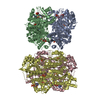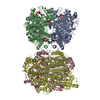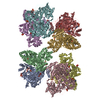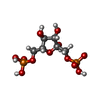[English] 日本語
 Yorodumi
Yorodumi- PDB-8w2j: Human liver phosphofructokinase-1 filament in the T-state conformation -
+ Open data
Open data
- Basic information
Basic information
| Entry | Database: PDB / ID: 8w2j | ||||||
|---|---|---|---|---|---|---|---|
| Title | Human liver phosphofructokinase-1 filament in the T-state conformation | ||||||
 Components Components | ATP-dependent 6-phosphofructokinase, liver type | ||||||
 Keywords Keywords | TRANSFERASE / PFK / glycolysis | ||||||
| Function / homology |  Function and homology information Function and homology information6-phosphofructokinase complex / 6-phosphofructokinase / fructose binding / 6-phosphofructokinase activity / fructose-6-phosphate binding / fructose 1,6-bisphosphate metabolic process / fructose 6-phosphate metabolic process / canonical glycolysis / Glycolysis / response to glucose ...6-phosphofructokinase complex / 6-phosphofructokinase / fructose binding / 6-phosphofructokinase activity / fructose-6-phosphate binding / fructose 1,6-bisphosphate metabolic process / fructose 6-phosphate metabolic process / canonical glycolysis / Glycolysis / response to glucose / glycolytic process / negative regulation of insulin secretion / kinase binding / secretory granule lumen / ficolin-1-rich granule lumen / Neutrophil degranulation / extracellular exosome / extracellular region / ATP binding / metal ion binding / identical protein binding / membrane / cytosol Similarity search - Function | ||||||
| Biological species |  Homo sapiens (human) Homo sapiens (human) | ||||||
| Method | ELECTRON MICROSCOPY / single particle reconstruction / cryo EM / Resolution: 3.1 Å | ||||||
 Authors Authors | Lynch, E.M. / Kollman, J.M. / Webb, B.A. | ||||||
| Funding support |  United States, 1items United States, 1items
| ||||||
 Citation Citation |  Journal: Nat Commun / Year: 2024 Journal: Nat Commun / Year: 2024Title: Structural basis for allosteric regulation of human phosphofructokinase-1. Authors: Eric M Lynch / Heather Hansen / Lauren Salay / Madison Cooper / Stepan Timr / Justin M Kollman / Bradley A Webb /   Abstract: Phosphofructokinase-1 (PFK1) catalyzes the rate-limiting step of glycolysis, committing glucose to conversion into cellular energy. PFK1 is highly regulated to respond to the changing energy needs of ...Phosphofructokinase-1 (PFK1) catalyzes the rate-limiting step of glycolysis, committing glucose to conversion into cellular energy. PFK1 is highly regulated to respond to the changing energy needs of the cell. In bacteria, the structural basis of PFK1 regulation is a textbook example of allostery; molecular signals of low and high cellular energy promote transition between an active R-state and inactive T-state conformation, respectively. Little is known, however, about the structural basis for regulation of eukaryotic PFK1. Here, we determine structures of the human liver isoform of PFK1 (PFKL) in the R- and T-state by cryoEM, providing insight into eukaryotic PFK1 allosteric regulatory mechanisms. The T-state structure reveals conformational differences between the bacterial and eukaryotic enzyme, the mechanisms of allosteric inhibition by ATP binding at multiple sites, and an autoinhibitory role of the C-terminus in stabilizing the T-state. We also determine structures of PFKL filaments that define the mechanism of higher-order assembly and demonstrate that these structures are necessary for higher-order assembly of PFKL in cells. | ||||||
| History |
|
- Structure visualization
Structure visualization
| Structure viewer | Molecule:  Molmil Molmil Jmol/JSmol Jmol/JSmol |
|---|
- Downloads & links
Downloads & links
- Download
Download
| PDBx/mmCIF format |  8w2j.cif.gz 8w2j.cif.gz | 1.8 MB | Display |  PDBx/mmCIF format PDBx/mmCIF format |
|---|---|---|---|---|
| PDB format |  pdb8w2j.ent.gz pdb8w2j.ent.gz | 1.6 MB | Display |  PDB format PDB format |
| PDBx/mmJSON format |  8w2j.json.gz 8w2j.json.gz | Tree view |  PDBx/mmJSON format PDBx/mmJSON format | |
| Others |  Other downloads Other downloads |
-Validation report
| Summary document |  8w2j_validation.pdf.gz 8w2j_validation.pdf.gz | 3.2 MB | Display |  wwPDB validaton report wwPDB validaton report |
|---|---|---|---|---|
| Full document |  8w2j_full_validation.pdf.gz 8w2j_full_validation.pdf.gz | 3.3 MB | Display | |
| Data in XML |  8w2j_validation.xml.gz 8w2j_validation.xml.gz | 168.6 KB | Display | |
| Data in CIF |  8w2j_validation.cif.gz 8w2j_validation.cif.gz | 243.3 KB | Display | |
| Arichive directory |  https://data.pdbj.org/pub/pdb/validation_reports/w2/8w2j https://data.pdbj.org/pub/pdb/validation_reports/w2/8w2j ftp://data.pdbj.org/pub/pdb/validation_reports/w2/8w2j ftp://data.pdbj.org/pub/pdb/validation_reports/w2/8w2j | HTTPS FTP |
-Related structure data
| Related structure data |  43750MC  8w2gC  8w2hC  8w2iC M: map data used to model this data C: citing same article ( |
|---|---|
| Similar structure data | Similarity search - Function & homology  F&H Search F&H Search |
- Links
Links
- Assembly
Assembly
| Deposited unit | 
|
|---|---|
| 1 |
|
- Components
Components
| #1: Protein | Mass: 85120.375 Da / Num. of mol.: 8 Source method: isolated from a genetically manipulated source Source: (gene. exp.)  Homo sapiens (human) / Gene: PFKL / Production host: Homo sapiens (human) / Gene: PFKL / Production host:  unidentified baculovirus / References: UniProt: P17858, 6-phosphofructokinase unidentified baculovirus / References: UniProt: P17858, 6-phosphofructokinase#2: Sugar | ChemComp-FBP / #3: Chemical | ChemComp-ATP / #4: Chemical | ChemComp-MG / Has ligand of interest | Y | |
|---|
-Experimental details
-Experiment
| Experiment | Method: ELECTRON MICROSCOPY |
|---|---|
| EM experiment | Aggregation state: PARTICLE / 3D reconstruction method: single particle reconstruction |
- Sample preparation
Sample preparation
| Component | Name: PFKL filament / Type: COMPLEX / Entity ID: #1 / Source: RECOMBINANT |
|---|---|
| Molecular weight | Experimental value: NO |
| Source (natural) | Organism:  Homo sapiens (human) Homo sapiens (human) |
| Source (recombinant) | Organism:  unidentified baculovirus unidentified baculovirus |
| Buffer solution | pH: 7.5 |
| Specimen | Embedding applied: NO / Shadowing applied: NO / Staining applied: NO / Vitrification applied: YES |
| Vitrification | Cryogen name: ETHANE / Humidity: 100 % |
- Electron microscopy imaging
Electron microscopy imaging
| Experimental equipment |  Model: Titan Krios / Image courtesy: FEI Company |
|---|---|
| Microscopy | Model: FEI TITAN KRIOS |
| Electron gun | Electron source:  FIELD EMISSION GUN / Accelerating voltage: 300 kV / Illumination mode: FLOOD BEAM FIELD EMISSION GUN / Accelerating voltage: 300 kV / Illumination mode: FLOOD BEAM |
| Electron lens | Mode: BRIGHT FIELD / Nominal magnification: 130000 X / Nominal defocus max: 2400 nm / Nominal defocus min: 800 nm |
| Specimen holder | Cryogen: NITROGEN |
| Image recording | Electron dose: 90 e/Å2 / Film or detector model: GATAN K2 SUMMIT (4k x 4k) |
- Processing
Processing
| EM software |
| |||||||||||||||||||||||||||||||||
|---|---|---|---|---|---|---|---|---|---|---|---|---|---|---|---|---|---|---|---|---|---|---|---|---|---|---|---|---|---|---|---|---|---|---|
| CTF correction | Type: PHASE FLIPPING AND AMPLITUDE CORRECTION | |||||||||||||||||||||||||||||||||
| 3D reconstruction | Resolution: 3.1 Å / Resolution method: FSC 0.143 CUT-OFF / Num. of particles: 45362 / Symmetry type: POINT | |||||||||||||||||||||||||||||||||
| Atomic model building | Protocol: FLEXIBLE FIT / Space: REAL | |||||||||||||||||||||||||||||||||
| Atomic model building | Source name: Modeller / Type: in silico model |
 Movie
Movie Controller
Controller





 PDBj
PDBj








